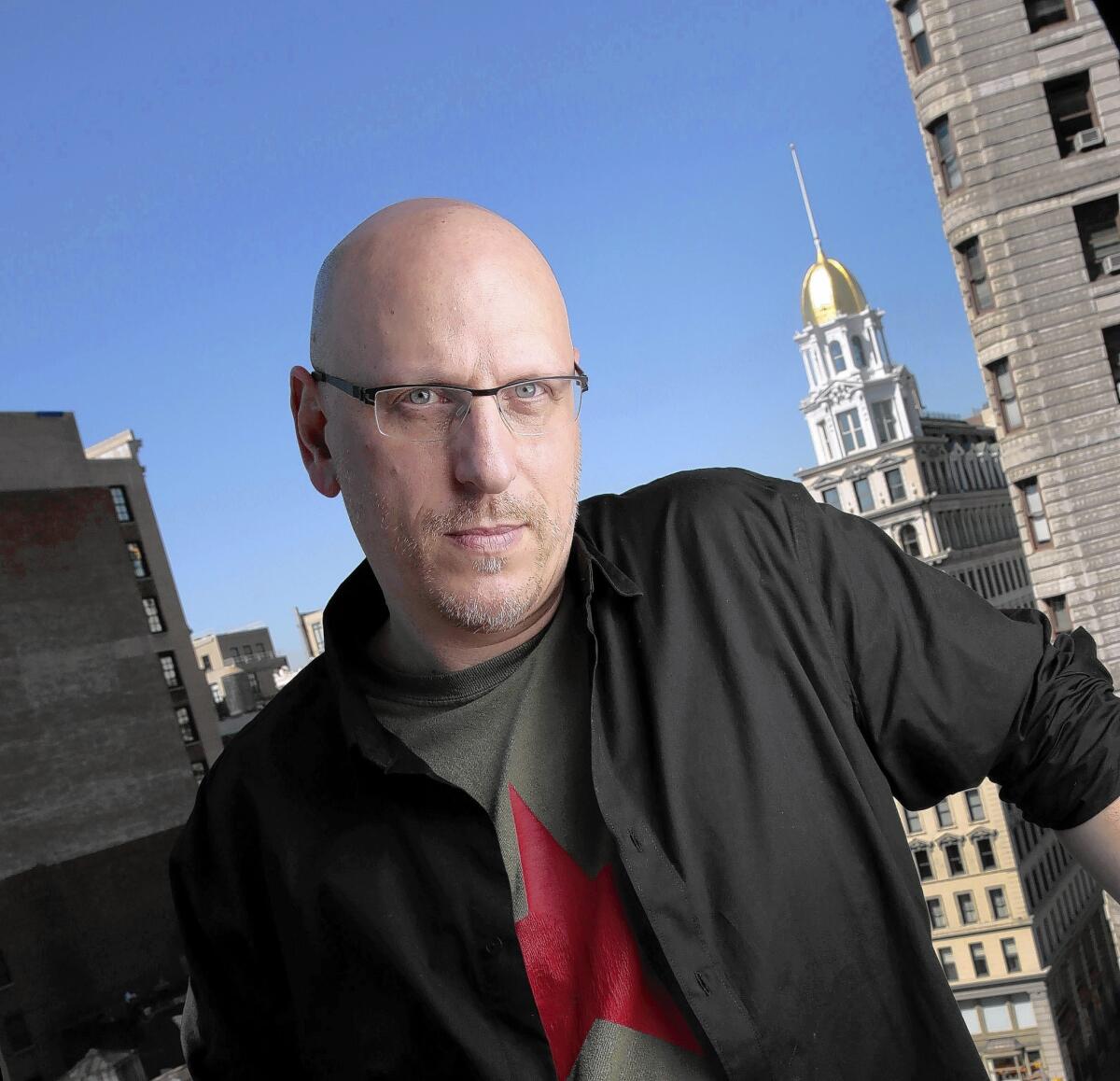With ‘Time Out of Mind,’ Oren Moverman seeks a new kind of boldness

- Share via
On the first day of shooting his new movie, director Oren Moverman had an unusual task for his star, Richard Gere: He wanted the famous actor to stand in New York City’s bustling Astor Place with an empty coffee cup begging for change.
Moverman needed the scene for “Time Out of Mind,” in which Gere radically goes against type to play a homeless man. But the filmmaker soon realized it served another purpose.
“Richard stood there for 40 minutes. No one gave him a cent. No one even recognized him,” Moverman said. “And that proved the whole point: The homeless are all around us and we don’t see them.”
Moverman hopes to heighten their visibility with his new film. Rigorously shot and calculatedly observational, “Time Out of Mind” is a look at a broken man’s life over the course of several hopeless, restless days.
When it premieres at the Toronto International Film Festival this weekend, “Time” will showcase an unconventional approach in technique and subject matter — and mark the latest turn for a filmmaker who has determinedly gone his own way.
Long regarded as one of independent film’s most innovative screenwriters — he wrote the experimental Bob Dylan picture “I’m Not There” and was the screenwriter on a second Toronto ’14 selection, the Brian Wilson film “Love & Mercy” — Moverman, 48, embarked on a well-received directorial path beginning five years ago with the military-bereavement drama “The Messenger.” He followed it up two years later with the Los Angeles Police Department corruption tale “Rampart.”
Told with unsettling intimacy, those pictures, each starring Woody Harrelson, revealed a director keen to examine the failure of institutions and the phenomenon of wounded masculinity often nestled within it.
Moverman continues exploring those ideas in “Time,” following George Hammond (an unkempt Gere) as he wanders the streets of New York seeking shelter both figurative and literal, occasionally guzzling booze but mostly just at loose ends as he carries around nothing but a plastic bag and plenty of ghosts.
“I’m kind of in between right now,” George frequently says to passersby who, by and large, are disinclined to help him. If he is in denial about his circumstances, he also has a strange sense of self-possession, a man who in his mind is the middle-class person he once was, not the vagabond whom others go out of their way to avoid.
Heartfelt but unsentimental, the film was shot in a kind of fly-on-the-wall style — a distant wall, anyway. Moverman kept the camera removed from the actors, sometimes even as far away as a building down the block. That allowed him to capture many real people who were unaware a movie was being shot, as well as a host of street sounds such as overheard conversations and loud sirens, nearly all of which he left in the film to give it an unusually authentic flavor.
Moverman and his longtime cinematographer Bobby Bukowski also tended to shoot George through glass — we watch the character through store windows, hospital sliding doors, reflections in an ice-cream truck and countless other transparent surfaces — so that viewers get the sense of peering in on a homeless man, even as everyone in the film, of course, can’t see him.
There is, notably, little exposition in “Time” — we receive flew clues as to how George ended up this way, leaving us to focus on how he must survive instead of with a more conventional narrative engagement.
“We have forgotten a certain kind of moviegoing experience that is much more abstract and ambiguous,” Moverman said this week over coffee a few blocks from where he edited “Time” in downtown Manhattan. “And since we were making a movie about just one of the many homeless people out there who we know nothing about, who I know nothing about, it all fit the theme quite nicely.” (He also added that he thought, in an era when “TV has the luxury of telling stories over so many hours, cinema might have to offer something different, something that’s maybe driven a little less by narrative.”)
The project took root when Gere ran into Moverman at a party (the actor starred in “I’m Not There”) and sent him a script about the homeless by a writer named Jeffrey Caine. Motivated by the jolting experience of seeing neighbors’ indifference to a mentally ill homeless man near his Manhattan apartment, Moverman took to the concept and began writing a draft. He and Gere were soon visiting homeless shelters to research the movie.
Financing wasn’t easy — many balked at the symbol of power from “Arbitrage,” “Pretty Woman” and “American Gigolo” playing a vagrant — but Moverman eventually landed the budget of about $5 million from a group of financiers including “Love & Mercy” director Bill Pohlad.
Moverman and Gere then set out on a street-set shoot, a no-frills production that had the actor waiting between takes drinking tea in a rental car. (Though it evokes a landmark Dylan album, the title is derived originally from Romeo and Juliet and an Edna St. Vincent Millay poem, and also has echoes of an archaic British law about objects that lack identification.)
There are moments of humanity in “Time” — a nurse, say, who has a dollop of pity — but far more often George encounters heartbreak, as many in a social-service system politely but regretfully tell him they cannot help.
In this regard, “Time” echoes the recent indie favorite “Short Term 12,” also an indictment of a system; without any form of identification, George learns, for all intents and purposes, he is not a person.
But the film, which is seeking U.S. distribution, is also a larger meditation on existence and how we quantify it, particularly for men on a downward spiral.
“I’ve always been fascinated with a breakdown of the male persona,” said Moverman, who has a hulking physique but a gentle, thoughtful manner; raised in Israel, he also served in the Israeli military, a possible factor in his preoccupations. “There’s something fascinating about these male-dominated institutions and characters who are not all right and dealing with emotions they don’t know how to express.”
Moverman’s other Toronto movie, biographical drama ”Love & Mercy,” examines a man struggling to hold it together at another end of the spectrum: the Beach Boys’ Brian Wilson as he comes under the spell of a polarizing doctor named Eugene Landy.
”These are both movies about men being off. Brian’s being off is genius and George’s being off is on the streets,” Moverman said. “I like looking at that and what it means, and I like the idea of using behavior as storytelling.
He added, “It’s always seemed to me like so much narrative is going on all the time, even just in a moment at a table in this restaurant — what someone is wearing, what they’re drinking, how they’re talking. There are so many stories happening. Observation just feels like the truest way to capture them.”
More to Read
Only good movies
Get the Indie Focus newsletter, Mark Olsen's weekly guide to the world of cinema.
You may occasionally receive promotional content from the Los Angeles Times.










